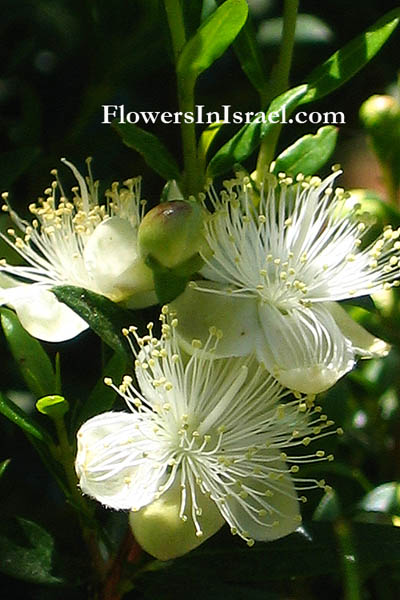
Derivation of the botanical name:
Myrtus, myrtos, μυρτοϛ, myrtle.
communis, common, ordinary.
The Hebrew name: הדס, hadas, myrtle; related to Aramaic: הדסא; Arabic: hadas.
- The standard author abbreviation L. is used to indicate Carl Linnaeus (1707 – 1778), a Swedish botanist, physician, and zoologist, the father of modern taxonomy.
The myrtle, Myrtus communis, is a shrub with evergreen leaves and small white flowers, which are produced in the middle of the summer.
The fruit is a small, black berry, resembling a blueberry and is edible but seldom eaten. The entire plant contains tannins, flavonoids and a volatile oil.
The first reference of the Myrtle in the Bible is in Nehemiah 8:15 in regard to the celebration of the Feast of Tabernacles.
In Hebrew myrtle is called "hadas" and is one of the Four Species (arba'ah minim-ארבעת המינים) used in a special ceremony during the Jewish holiday of Sukkot (Feast of Tabernacles).
- To the ancient Jews it was symbolic not only for peace, but also for justice. The name Hadassah (Esther), is very similar to the Hebrew word for myrtle and the Targums say: "They call her Hadassah, because she was just, and those that are just are compared to myrtles".
- In ancient Greece, myrtle was sacred to Aphrodite, goddess of love and beauty. To the Renaissance (c. 1350-1600), since it was forever green, it symbolized everlasting love, in particular conjugal fidelity. A bride would wear it on her wedding day.
- In Christian religion, the myrtle has been associated with the Virgin Mary.
- Dioscorides describes the preparation of the volatile oil as follows:
MURSINELAION. Oil of Myrtle
(Englished by John Goodyer, 1655 CE.)
Myrtinum Oleum is prepared thus, taking ye tender leaves of black Myrtle, whether wilde or planted, beat them, pressing out the Juice, then mixing the like quantitie of Omphacine oyle to ye juice, warme it over the coales until it be sod together, taking away that which is uppermost. But ye more easy way of preparation is, to seeth the most tender of the leaves (after they are pounded) in water & oyle, & to skimme off that which swims on the top, & after a peculiar manner, having layd the leaves in ye Sun, to macerate them in oyly. But there are some who thicken the oyle first with Malicoria, Cupressus, Cyperus, Iuncus odoratus. But the most effectuall is that enclining to bitternesse in ye taste, & oilie, green, transparent, smelling of Myrtle. The force of it is binding, hardening, wherefore it is effectual, being mixed obducentibus medicamentis. It is good also ad Ambustiones, ulcera capitis manantia, Furfures, Papularum eruptiones, Rhagadas, galls, Condylomata, articulos laxatos, it represseth sweats, & is good for all thinges that have need of binding or thickning.
- In Pliny's time this myrtle oil was one of the commonest balms, and it was also believed to be one of the oldest.
- Theophrastus said that it was marvellously fragrant and that the berries tasted like wine. He prescribed myrtle for fumigation, poultices and beverages.
-
Myrtle is nowadays used as an astringent and antiseptic.
See the list of Medicinal herbs in Israel, the parts used and their medical uses to treat various diseases.
Bible resources:
- Nehemiah 8:15
and that they should proclaim this word and spread it throughout their towns and in Jerusalem: “Go out into the hill country and bring back branches from olive and wild olive trees, and from myrtles, palms and shade trees, to make temporary shelters”—as it is written.
- Esther 2:7
Mordecai had a cousin named Hadassah, whom he had brought up because she had neither father nor mother. This young woman, who was also known as Esther, had a lovely figure and was beautiful. Mordecai had taken her as his own daughter when her father and mother died.
- Isaiah 41:19
I will put in the desert the cedar and the acacia, the myrtle and the olive. I will set junipers in the wasteland, the fir and the cypress together,
- Isaiah 55:13
Instead of the thornbush will grow the juniper, and instead of briers the myrtle will grow. This will be for the LORD’s renown, for an everlasting sign, that will endure forever.”
- Zechariah 1:7
[ The Man Among the Myrtle Trees ] On the twenty-fourth day of the eleventh month, the month of Shebat, in the second year of Darius, the word of the LORD came to the prophet Zechariah son of Berekiah, the son of Iddo.
- Zechariah 1:8
During the night I had a vision, and there before me was a man mounted on a red horse. He was standing among the myrtle trees in a ravine. Behind him were red, brown and white horses.
- Zechariah 1:10
Then the man standing among the myrtle trees explained, “They are the ones the LORD has sent to go throughout the earth.”
- Zechariah 1:11
And they reported to the angel of the LORD who was standing among the myrtle trees, “We have gone throughout the earth and found the whole world at rest and in peace.”
|

